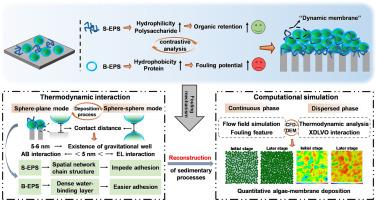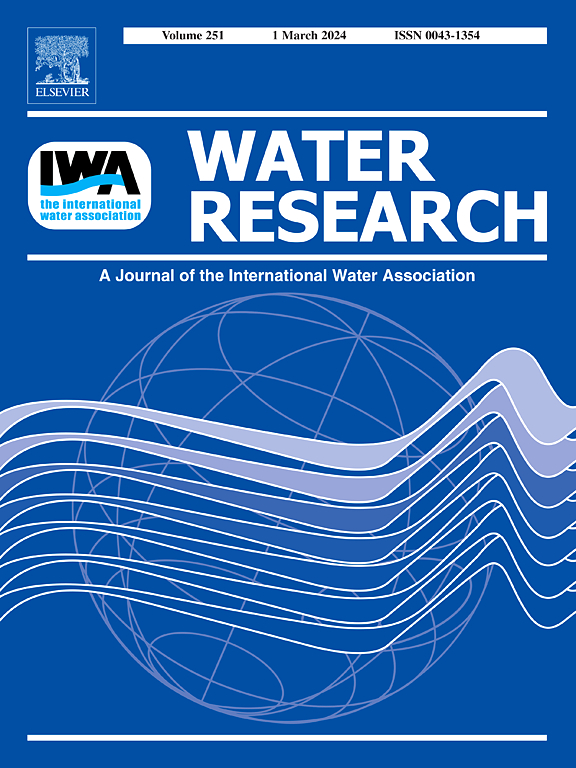Unveiling the role of stratified extracellular polymeric substances in membrane-based microalgae harvesting: thermodynamic and computational insights
IF 11.4
1区 环境科学与生态学
Q1 ENGINEERING, ENVIRONMENTAL
引用次数: 0
Abstract
Membrane separation technology has emerged as a highly energy-efficient method for microalgae enrichment and harvesting in wastewater treatment. However, membrane fouling caused by algal cells and stratified extracellular polymeric substances (EPS) remains a critical barrier to its industrial-scale application. This study meticulously investigates the micro process of algae-derived pollutants stacking to the membrane surface affected by stratified EPS. The fouling process resulting from algal cell particle deposition and cake layer formation are clearly simulated using a semi-coupled computational method of Computational Fluid Dynamics (CFD)-Discrete Element Method (DEM) for the first time. The results reveal that the hydrophilic component and spatial network structure of soluble EPS (S-EPS) effectively impede the algae-membrane adhesion, and enable the algal cake layer exhibit "dynamic membrane" characteristic to enhance the organic matter retention. In contrast, bound EPS (B-EPS) with higher protein content exhibits a stronger fouling potential and adhesion tendency of algal cells. The influence of stratified EPS on the variation of thermodynamic interaction with contact scale in the sphere-plane/sphere-sphere model is inventively conducted. Based on different algal cell filtration modes, a sequential increase in the eigenvalue n was observed by delaminating EPS layer by layer, indicative of a more severe membrane pore blockage. The semi-coupled CFD-DEM method provides a quantitative analysis of the deposition process, offering spatial resolution and force analysis for algal-derived pollutants. Additionally, we propose a novel calculation method to reverse the deposition process based on the particle stress, providing a valuable reference for simulating membrane-based microalgae harvesting under the influence of stratified EPS.

揭示层状细胞外聚合物质在膜基微藻收获中的作用:热力学和计算见解
膜分离技术作为一种高效节能的污水处理微藻富集和收获方法已经出现。然而,由藻类细胞和层状细胞外聚合物(EPS)引起的膜污染仍然是其工业规模应用的关键障碍。本研究细致地研究了藻源污染物在分层EPS影响下向膜表面堆积的微观过程。首次采用计算流体力学(CFD)-离散元法(DEM)半耦合计算方法,清晰地模拟了藻细胞颗粒沉积和饼层形成的污染过程。结果表明,可溶性EPS (S-EPS)的亲水成分和空间网络结构有效地阻碍了藻膜的粘附,使藻饼层表现出“动态膜”特性,增强了有机物的滞留性。相比之下,蛋白质含量较高的结合型EPS (B-EPS)对藻类细胞的污染潜力和粘附倾向更强。在球-平面/球-球模型中,创造性地研究了层状EPS对热力学相互作用随接触尺度变化的影响。根据不同的藻类细胞过滤方式,通过逐层剥离EPS,观察到特征值n的顺序增加,表明膜孔堵塞更严重。半耦合CFD-DEM方法提供了沉积过程的定量分析,提供了藻类衍生污染物的空间分辨率和力分析。此外,我们还提出了一种基于颗粒应力的反沉积过程计算方法,为模拟分层EPS影响下的膜基微藻收获提供了有价值的参考。
本文章由计算机程序翻译,如有差异,请以英文原文为准。
求助全文
约1分钟内获得全文
求助全文
来源期刊

Water Research
环境科学-工程:环境
CiteScore
20.80
自引率
9.40%
发文量
1307
审稿时长
38 days
期刊介绍:
Water Research, along with its open access companion journal Water Research X, serves as a platform for publishing original research papers covering various aspects of the science and technology related to the anthropogenic water cycle, water quality, and its management worldwide. The audience targeted by the journal comprises biologists, chemical engineers, chemists, civil engineers, environmental engineers, limnologists, and microbiologists. The scope of the journal include:
•Treatment processes for water and wastewaters (municipal, agricultural, industrial, and on-site treatment), including resource recovery and residuals management;
•Urban hydrology including sewer systems, stormwater management, and green infrastructure;
•Drinking water treatment and distribution;
•Potable and non-potable water reuse;
•Sanitation, public health, and risk assessment;
•Anaerobic digestion, solid and hazardous waste management, including source characterization and the effects and control of leachates and gaseous emissions;
•Contaminants (chemical, microbial, anthropogenic particles such as nanoparticles or microplastics) and related water quality sensing, monitoring, fate, and assessment;
•Anthropogenic impacts on inland, tidal, coastal and urban waters, focusing on surface and ground waters, and point and non-point sources of pollution;
•Environmental restoration, linked to surface water, groundwater and groundwater remediation;
•Analysis of the interfaces between sediments and water, and between water and atmosphere, focusing specifically on anthropogenic impacts;
•Mathematical modelling, systems analysis, machine learning, and beneficial use of big data related to the anthropogenic water cycle;
•Socio-economic, policy, and regulations studies.
 求助内容:
求助内容: 应助结果提醒方式:
应助结果提醒方式:


